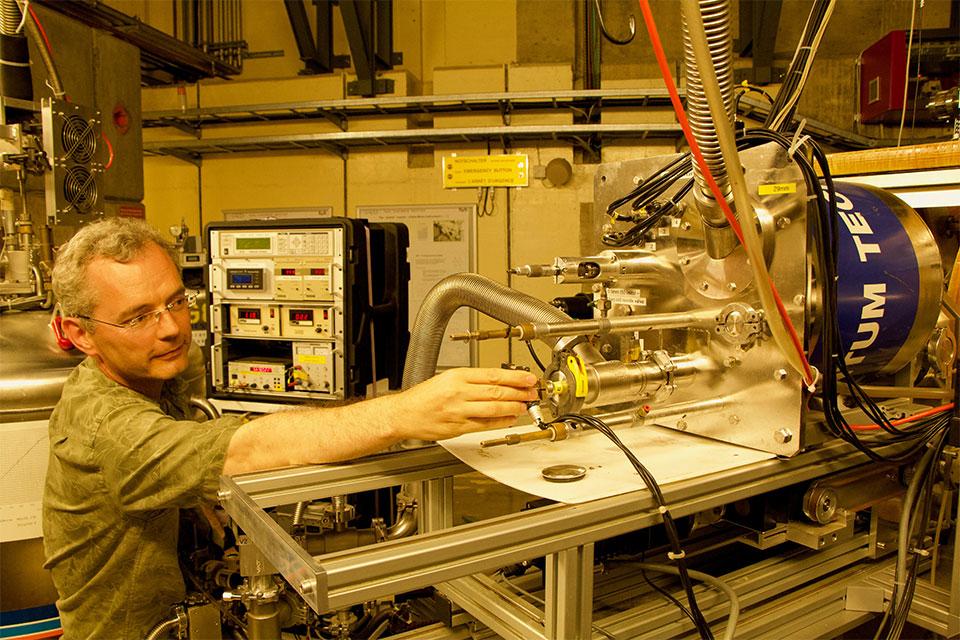Professor Stephen Blundell has been awarded an ERC Advanced Grant designed to support excellent scientists who are already established research leaders with a recognised track record of research achievements. Here he writes about the science behind the award:
I am absolutely thrilled about the award of this ERC Advanced Grant as it gives me the chance to develop some exciting new techniques that will use muons to learn about quantum spin liquids. I have been working with muons since I came to Oxford nearly three decades ago. Muons are amazing particles, and are the dominant constituent of cosmic rays, meaning that some are falling on you right now, like a very gentle rain, as you read your computer screen.
The amazing thing about muons is that they can be completely spin polarised, meaning that their magnetic moments can be fully lined up. If you point a beam of such particles towards a magnetic sample, they will all come to rest inside the crystal lattice and then their magnetic moments will precess at a rate governed by the magnetic field they experience. By measuring this precession we can measure precisely the magnetic field inside the crystal lattice, and even extract the time-dependence of the magnetic field if varies. The complete spin polarisation of the muons gives them exquisite sensitivity.
Speed and transparency
But where exactly do the muons land inside the crystal lattice? To find out, my group developed a theoretical technique to work this out, but this method behaves a bit like a black box. It produces a reliable answer, but quite how it does it is rather opaque, and the whole process is computationally expensive. One strand of the new project will introduce some much-needed transparency and lead to some new, speedier empirical methods for understanding and extracting these so-called muon sites.
A second strand of the project will marry these exotic muon methods with good, old-fashioned, pulsed nuclear magnetic resonance and electron spin resonance techniques that have proven so useful in physics, chemistry, and biology (and which incidentally the Clarendon Laboratory at Oxford played a major role in developing). Rather than sitting back and watching the muons precess in the sample (as we do at present), we will then be able to use highly-specified sequences of radio frequency and microwave pulses to directly control the spins in the sample. This will allow entirely new experiments to be attempted.
Novel advances
These novel advances will, I hope, allow a new view of a long-standing problem in this field: the study of quantum spin liquids. Magnetic spins on a lattice tend to align into an ordered configuration at low temperature, but in quantum spin liquids they can’t. Instead, they adopt a very unusual highly-correlated liquid-like state. It’s not random, since the spins are highly entangled, and the quantum spin liquid state involves the superposition of many individual configurations (Schrödinger’s cat famously involves just two configurations!) The techniques I’m developing will allow muons to shed a new light on the spin dynamics that persist to low-temperature in these highly exotic materials.
What will this lead to? It’s hard to say, as this is long-term fundamental work and the outcomes could go in many different directions. I can simply note that modern technology is built upon exploiting newly-discovered electronic properties of materials, perhaps for energy storage, information storage, or many other applications. Some of the most exciting recent developments are coming from using exotic quantum properties of materials, and developing new techniques to understand those quantum properties in detail is going to help in crafting the materials of the future.
Thriving centre for quantum materials research
Oxford is such a wonderful place to pursue this research. The nearby Rutherford Appleton Laboratory hosts the ISIS Pulsed Muon Source which produces the muons I will use for many of the experiments, but in addition the University is a thriving centre for research on quantum materials, meaning that I’m surrounded by numerous interesting colleagues with diverse expertise in these areas. We’re all motivated by the absorbing quest to discover more about how the beautiful machinery of quantum mechanics plays out in the many-body systems that inhabit crystals that you can hold between thumb and forefinger!

